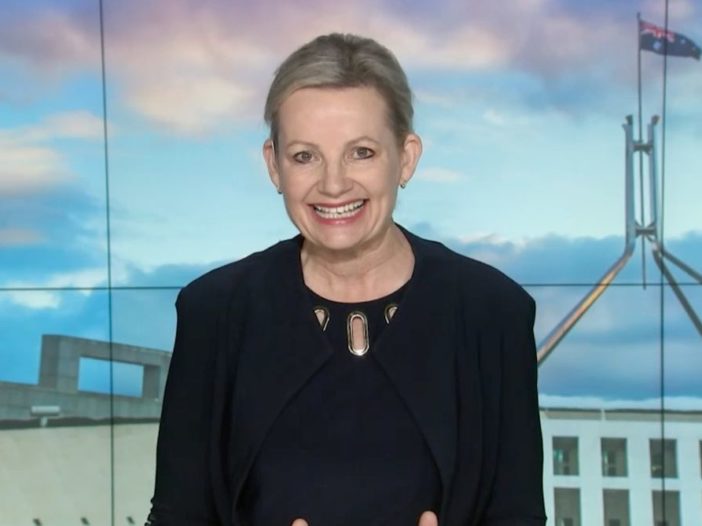“Blindsided,” says Ley, as developers reel from minister’s shock renewable hydrogen decision
Sussan Ley #SussanLey



The federal environment minister’s decision to block the development of the massive Asian Renewable Energy Hub, proposing up to 26GW of solar and wind green-powered green hydrogen production, has come as a complete surprise to the project’s developers and was delivered without any prior consultation.
RenewEconomy understands that the consortium behind the massive and industry-leading project knew nothing of Sussan Ley’s concerns about the Hub’s “clearly unacceptable” impacts before her decision late last week to declare the proposal environmentally unfit to proceed.
As reported on Monday, the Hub, proposed for development by Intercontinental Energy, Australia’s CWP Global, Pathway Investments and turbine manufacturer Vestas, was rejected by Ley despite having been awarded ‘major project’ status by the Morrison government in October last year.
The initial proposal for a 9GW project – including roughly 7GW of wind, 2GW of solar and four subsea power cables – had secured environmental approval from the Western Australia government, following a favourable recommendation from the Environmental Protection Authority in May of 2020.
The consortium has since shifted the focus of the renewable export part of its plan from exporting electrons via undersea cables to exporting green ammonia – a green hydrogen derived fuel with potential to displace LNG and other fossil fuels in industrial applications.
This would be done via undersea pipelines extending 20km off the WA coast and into Commonwealth waters, where the green ammonia would be loaded onto ships. It would also involve the construction of a seawater desalination plant, to create fresh water for electrolysis, as well as intake and discharge pipelines and, of course, renewable hydrogen electrolysers.
But one of the biggest surprises about minister Ley’s decision on the project has been the speed at which it was delivered; in advance of the updated AREH project’s impact modelling being completed – a deviation from normal process, you might say – and with zero consultation.
The situation would be bizarre enough on its own, but on Tuesday was imbued with a heavy sense of irony when the environment minister popped up on television screens complaining of being “blindsided” by the draft recommendation from UNESCO that Australia’s Great Barrier Reef be listed as “endangered.”
“We were blindsided by a sudden late decision,” Ley said during an ABC TV interview on Tuesday morning.
“It is almost unheard of for a site to be added to the endangered list, or recommended … without the necessary consultation leading up to it.
“It is a deviation from normal process.”
In reality, the UN body’s warnings to Australia about the reef’s declining state of health have been, at the very least, an annual ritual for the better part of a decade.
As The Conversation pointed out here, the federal government’s own experts in 2019 downgraded the Reef’s outlook from “poor” to “very poor” in what was then the latest five-yearly report from the Great Barrier Reef Marine Park Authority.
“The report assessed literally hundreds of scientific studies published on the reef’s declining condition since the last report was published in 2014,” James Cook University Professor Terry Hughes wrote at the time.
Minister Ley, who held the environment portfolio then, too, responded at the time by declaring the GBR as “the best managed reef in the world” – and she repeated that assertion on Tuesday. So her shock at UNESCO’s draft decision might be more appropriately credited to the federal Coalition government’s uncanny powers of denial in the face of irrefutable scientific evidence, rather than a lack of consultation. A Great Barrier to Science, if you will.
“This decision is unfortunate but probably not surprising,” said William Figueira, Associate Professor of Marine Animal Biology at the University of Sydney. “The GBR has been hit by three consecutive bleaching events in the last five years and there are now only a few places on the reef that have avoided impact.”
“I don’t know why Sussan Ley was blindsided as the push to have the GBR on the endangered list has been on the agenda for some time,” added Professor Elaine Baker, UNESCO chair of the School of Geosciences at the University of Sydney and Director of the University’s Marine Studies Institute.
“Australia is not playing its part in reducing CO2 emissions and we have a lot to lose. It’s estimated that the GBR contributed $6.4 billion (p.5) in 2015-16 financial year, according to Deloitte.”
How can Gov be surprised by a recommendation for listing Great Barrier Reef as World Heritage ‘In Danger’, UNESCO have been warning of this since 2012! And STILL the Govt has no climate policy. Their climate inaction imperils the 60K jobs on the Reef -and the Reef itself! #auspol
— Larissa Waters (@larissawaters) June 21, 2021
Much to her ssurprisse Environment Minisster Sussan Ley learnss the Barrier Reef iss endangered. https://t.co/pgZjpyuyQh
— Mike Carlton (@MikeCarlton01) June 21, 2021
Meanwhile, back at the renewable hydrogen ranch, the AREH consortium will have to get back to the drawing board on a project it believes to be at the leading edge of the renewable energy transition and had hoped to have up and running by 2025.
“We’ve got an enormous challenge ahead of us to decarbonise the world in the way that is needed to limit runaway climate change,” CWP Global’s Andrew Dickson told RenewEconomy’s Energy Insiders podcast in May.
“So we need a rapid transition away from fossil fuels. And ammonia energy is a really key way to do that at scale. So we need lots of projects like ours. We want others to succeed.”
And there are plenty of “others” who, likewise, will be wondering what this sudden and unconventional – and as yet largely unexplained – federal government decision will mean for the broader industry. Blindsided, indeed.